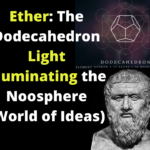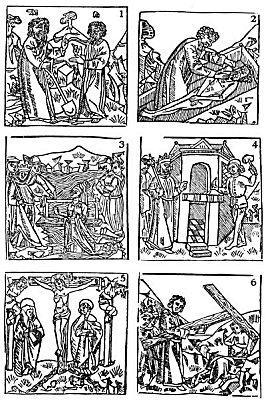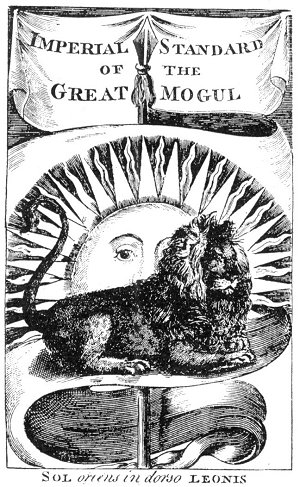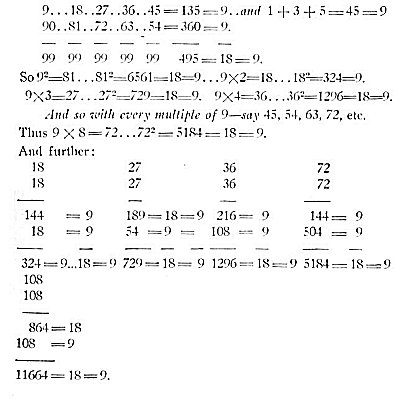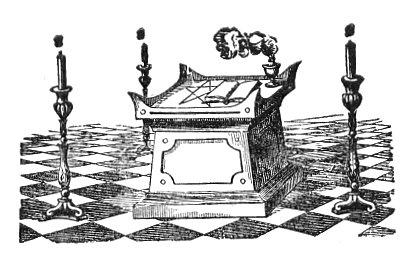Page 147
pent itself is the symbol of Kneph, the hidden, or unrevealed deity — God the Father. Time is winged, therefore the serpent is represented with wings. If we remember that each of the four evangelists is represented as having near him one of the described animals — grouped together in Solomon’s triangle in the pentacle of Ezekiel, and to be found in the four cherubs or sphinxes of the sacred arch — we will perhaps understand the secret meaning, as well as the reason why the early Christians adopted this symbol; and how it is that the present Roman Catholics and the Greeks of the Oriental Church still represent these animals in the pictures of their evangelists which sometimes accompany the four Gospels. We will also understand why Irenaeus, Bishop of Lyons, had so insisted upon the necessity of the fourth gospel; giving as a reason that there could not be less than four of them, as there were four
zones in the world, and four principal winds coming from the four cardinal points, etc. According to one of the Egyptian myths, the phantom-form of the isle of Chemmis (Chemi, ancient Egypt), which floats on the ethereal waves of the empyrean sphere, was called into being by Horus-Apollo, the sun-god, who caused it to evolve out of the mundane egg.
In the cosmogonical poem of Voluspa (the song of the prophetess), which contains the Scandinavian legends of the very dawn of ages, the phantom-germ of the universe is represented as lying in the Ginnungagap — or the cup of illusion, a boundless and void abyss. In this world’s matrix, formerly a region of night and desolation, Nebelheim (the Mist-place) dropped a ray of cold light (aether), which overflowed this cup and froze in it. Then the Invisible blew a scorching wind which dissolved the frozen waters and cleared the mist. These waters, called the streams of Elivagar, distilled in vivifying drops which, falling down, created the earth and the giant Ymir, who only had “the semblance of man” (male principle). With him was created the cow, Audhumla (female principle), from whose udder flowed four streams of milk, which diffused themselves throughout space (the astral light in its purest emanation). The cow Audhumla produces a superior being, called Bur, handsome and powerful, by licking the stones that were covered with mineral salt.
Now, if we take into consideration that this mineral was universally
Page 148
regarded by ancient philosophers as one of the chief formative principles in organic creation; by the alchemists as the universal menstruum, which, they said, was to be wrought from water; and by every one else, even as it is regarded now by science as well as in the popular ideas, to be an indispensable ingredient for man and beast; we may readily comprehend the hidden wisdom of this allegory of the creation of man. Paracelsus calls salt “the centre of water, wherein metals ought to die,” etc., and Van Helmont terms the Alkahest, “summum et felicissimum omnium salium,” the most successful of all salts. In the Gospel according to Matthew, Jesus says: “Ye are the salt of the earth: but if the salt have lost his savor, wherewith shall it be salted?” and following the parable he adds: “Ye are the light of the world” (v. 14). This is more than an allegory; these words point to a direct and unequivocal meaning in
relation to the spiritual and physical organisms of man in his dual nature, and show, moreover, a knowledge of the “secret doctrine,” the direct traces of which we find equally in the oldest ancient and current popular traditions, in both the Old and New Testaments, and in the writings of the ancient and mediaeval mystics and philosophers.
But to return to our Edda-legend. Ymir, the giant, falls asleep, and sweats profusely. This perspiration causes the pit of his left arm to generate out of that place a man and a woman, while his foot produces a son for them. Thus, while the mythic “cow” gives being to a race of superior spiritual men, the giant Ymir begets a race of evil and depraved men, the Hrimthursen, or frost-giants. Comparing notes with the Hindu Vedas, we find it then, with slight modifications, the same cosmogonic legend in substance and details. Brahma, as soon as Bhagaveda, the Supreme God, endows him with creative powers, produces animated beings, wholly spiritual at first. The Dejotas, inhabitants of the Surg’s (the celestial) region, are unfit to live on earth, therefore Brahma creates the Daints (giants, who become the dwellers of the Patals, the lower regions of space), who are also unfit to inhabit Mirtlok (the earth). To palliate the evil, the creative power evolves from his mouth the first Brahman, who thus becomes the progenitor of our race; from his right arm Brahma creates Raettris, the warrior, and from his left Shaterany, the wife of Raettris. Then their son Bais springs from the right foot of the creator, and his wife Basany from the left. While in the Scandinavian legend Bur (the son of the cow Audhumla), a superior being, marries Besla, a daughter of the depraved race of giants, in the Hindu tradition the first Brahman marries Daintary, also a daughter of the race of the giants; and in Genesis we see the sons of God taking for wives the daughters of men, and likewise producing mighty men of old; the

Moe is the founder of GnosticWarrior.com. He is a father, husband, author, martial arts black belt, and an expert in Gnosticism, the occult, and esotericism.

